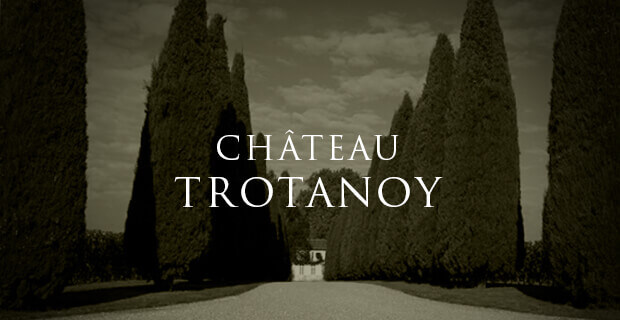
Chateau Trotanoy Wines
The peculiar name of Chateau Trotanoy echoes the history of the estate, dating back to the 18th century, when the property was nicknamed “Trop Ennuie.” This means something like “too much of a...Read More

In stock. Available for pick-up at store

In stock. Available for pick-up at store

In stock. Available for pick-up at store

In stock. Available for pick-up at store

Expected arrival date: October 29, 2027.

Pre-arrivals – 2 to 4 months delivery
Chateau Trotanoy | A Renaissance on the Pomerol Plateau

Stretching their roots deep into the clay and gravel soils of the legendary Pomerol plateau are the very old vines of Chateau Trotanoy. Owned and managed by the Moueix family since 1953, this historical estate has in recent decades risen to the very top of the list of Pomerol’s most magnificent references. Their wines are perfectly balanced and refined expressions of terroir with a remarkable potential for age, offering a whirlwind of black fruit, chocolate and wild mushroom aromas from Merlot (dominating the blend), complemented by the spicy touch of Cabernet Franc.
From “Trop Ennuie” to Trotanoy
The atypical name of Chateau Trotanoy is actually very telling of its early origins, sometime before the 18th century. Back then, the estate was actually named “Trop Ennuie,” which translates to something like “too much of a bother” or “too annoying” in English. This unfortunate name definitely did not refer to the experience of tasting this wine, which even back then was considered one of the most beautiful references of Pomerol, but to the tedious vineyard work required to make it. Indeed, the terroir of the property is characterized by a dense mixture of clay and gravel, which dries out and hardens after rain, making it very difficult to work. When the Giraud family purchased the property during the 18th century, they realized the wine was perhaps best marketed under a different label, so they renamed the estate Chateau Trotanoy and sold the wine under the new name “Pomerol Giraud Cru de Trotanoy.” By the 19th century, the wines of the property were famous for quality, but this Golden Era did not last very long. Phylloxera, compounded by wars and economic depression, led to a messy succession of owners and inconsistencies in management at the chateau. The vineyard was reduced from its original 25 hectares to only 7 hectares of deserted vines.

In 1953, a neglected Chateau Trotanoy was purchased by Jean-Pierre Moueix, who was at that time already quite well known for having revived the nearby Chateau Petrus. In 1964, Moueix hired a young man from Basque country named Jean-Claude Berrouet as winemaker of his estates, including Petrus, Chateau Magdelaine (now fused with Chateau Belair-Monange) and Chateau Trotanoy. After 44 vintages, Berrouet retired in 2007, but stayed on as consultant and appointed Eric Muriasco as Technical Director of Trotanoy.
Chateau Trotanoy: Sustainably Managed Vineyards in an Idyllic Pomerol Terroir
Chateau Trotanoy encompasses a 7.2 hectare (17.8 acre) vineyard, situated in the heart of the Pomerol plateau, sloping gently westward. The highest points of the vineyard are home to a soil with abundant gravel, while clay dominates the soil lower down. This clay sits atop a subsoil of red gravel and a layer of hard “crasse de fer,” rich in iron. It is this diversity of different but complementary soil types that is believed to lend to the estate’s wines their signature power, depth and complexity. The vineyards of Chateau Trotanoy were some of the only ones in Pomerol not to be damaged by the frost of 1956 and the high survival rate of its vines has pushed up the average age, which is around 35 years old today.

The vineyards are cultivated by means of sustainable viticultural techniques, with the soil tilled in four different ways and the vine growth management closely adapted to the climatic conditions of the vintage. The vines are severely pruned in the winter, followed by crop-thinning, de-leafing and stripping away some of the clusters in the summer in order to reduce yields and achieve only the best, most concentrated fruit. The vineyard is planted with 90% Merlot and 10% Cabernet Franc, reflecting – more or less – the proportions of the final blend.
Winemaking and Style of Chateau Trotanoy
Following a manual harvest, involving both a primary manual sorting in the vineyard and a secondary optical sorting with two sorting machines at the winery, the grapes are vinified in thermoregulated concrete vats. The winemaking at Chateau Trotanoy is characterized by very gentle and closely moderated maceration and extraction processes. The wine spends 16 to 18 months maturing in French oak barrels, of which around 50% are new. The wines of Chateau Trotanoy have become widely known for being ideally balanced, refined and concentrated, with a tremendous potential for age. The 2014 displays a brilliant structure and purity, with a pleasant spiciness on the finish, while the superb 2015 vintage is already revealing gorgeous aromas of black fruit preserves, blueberry compote, chocolate and touches of wild mushrooms.

Starting with the 2009 vintage, the estate has also produced a second wine named Esperance de Trotanoy from a selection of gravel-based parcels located in the northeastern section of the property. Esperance is more fruit-forward in profile than its older brother and is approachable even after just a few years in the bottle. Nevertheless, this Pomerol still displays the depth, complexity and concentration that has become the hallmark of the chateau’s wines. Like Chateau Trotanoy, Esperance de Trotanoy is vinified in small concrete tanks and matured in French oak barrels. It is only produced in small quantities and only when the conditions of the vintage allow for it.